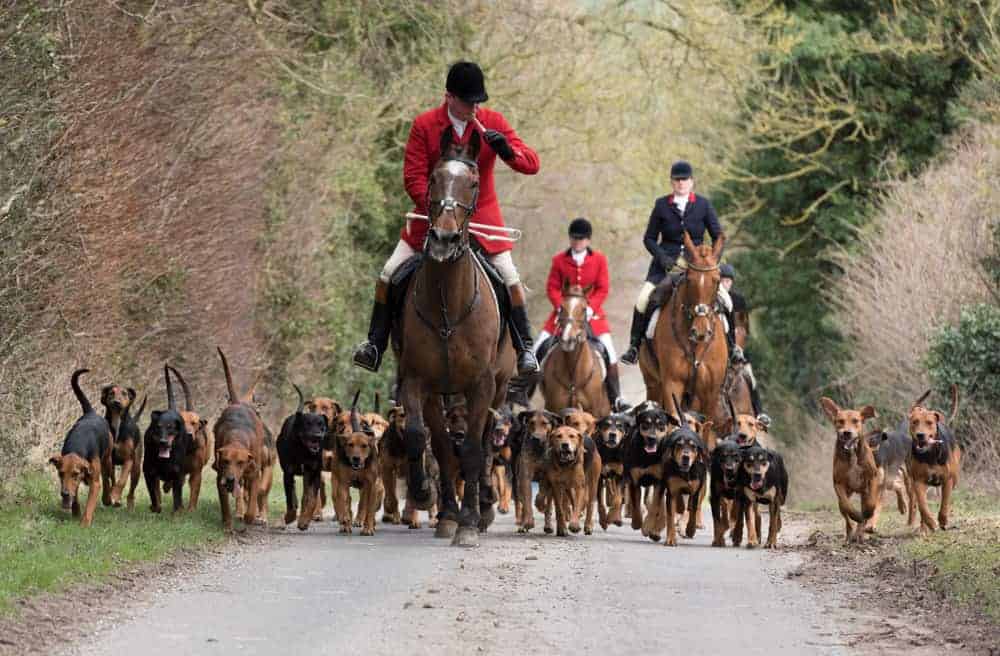Everything you wanted to know about drag hunting, but were afraid to ask

Caroline Orme Photography
It’s silly season again – and no, we’re not talking about Christmas. We mean drag hunting. It’s a thrilling way to spend an afternoon and not nearly as scary as you think!
To find out more we spoke to Phoebe Hobby, honorary secretary for the Berks and Bucks Draghounds, who took Kelly Marks out hunting for the first time, in an episode of Top Marks.
How does drag hunting differ from fox hunting?
In drag hunting, a pack of hounds follows a scent laid by a human rather than pursuing a live animal. The line is laid over a pre-determined route to take advantage of the best jumping opportunities.
Drag hunting was developed in the UK in the early 1800s to test the speed and agility of hounds, by laying a scent trail over a specified distance.
There are two ways to lay a scent. Bloodhounds have an amazing sense of smell and simply track a human, which is known as ‘hunting the clean boot’. The runner meet the hounds before the hunt and then sets off 20 minutes before the hunt.
The second way, more commonly used with foxhounds, is to follow a chemical scent. The runner dips a cloth in the scent mixture and drags it along the ground behind them.
Just how scary it is?
I am a wimp, but I do enjoy cantering. I suppose you do have to be a little brave, but really it’s just great fun!
What can we expect from a day’s hunting?
The meet starts at 12.30pm and if it is a lawn meet the host will offer drinks and snacks. Before moving off, the field master informs the followers (the ‘field’) of anything they need to know about the first line.
You should never pass the field master when the hunt sets off. The hounds will then move off and when they pick up the scent and start to run, the rest of the field follows jumping the fences along the way.
A normal meet has three or four lines covering up to six or more miles, but riders can miss out a line if they feel it will be too much for their horses. At the end of each line, there is a fifteen-minute break to allow the horses and riders to recover.
You will be out for around three hours and at the end of the day there is often tea at the host’s house, or in a local pub.
What is the best way to introduce your horse to hunting?
I always recommend introducing an inexperienced horse to hunting by taking him out gently for two or three times. Don’t jump everything in sight and make sure you do a certain amount of standing still so they can watch what is going on. Then, when you have a nice calm relaxed hunter then you can kick on and do everything!
There seem to be different types of meets, how do they differ?
Hound rides are generally at the beginning of the season and teach the young hounds to join the pack. They are more sedate, as the horses and hounds won’t be fit yet, but there will still be canters and a few jumps.
Pre-season meets are the next stage, and teach the younger hounds to hunt and scent. At these meets the field go at a good hunting pace, jumping quite a few smaller jumps, but they are not as long as main season meets.
Children’s meets are in a controlled area, with small (optional) jumps and a slower pace and lots of breaks to allow everyone to catch up.
How big are the jumps?
This changes from meet to meet. Our fences vary from 60cm (2ft) to 1.20 (4ft), however we don’t have many 1.20m ones these days as people generally prefer fences between 90cm (2ft9in) and 1.10 (3ft6in). The bigger ones are only ever hedges, which are inviting to jump and there are ways around them.
We try to keep lots of alternatives and have a second field master to assist with easier lines. To find out the best meets to suit you and your horse there are guides on our web site, or you can call the hunt secretaries for advice.
What should we wear?
Dress code is the same as for fox hunting. A hacking jacket and tie with buff britches is perfectly correct at any time during the season. Many people wear a black jacket with a white stock, but only hunt officials wear red coats.
As with any cross-country riding, you should make sure you wear the best crash hat available and back protectors are advisable.
What should our horse wear?
It’s best to wear the kit they would go normally wear going cross-country. Some people put boots on their horses and some don’t – it’s down to personal preference.
Do we have to plait?
Yes, you should plait for the main season meets.
What type of horse do we need?
All sorts of horses and ponies come out drag hunting. You don’t need a fast horse, but he does need to be capable of jumping at least 90cm (2ft9in). Put a green ribbon in his tail if he hasn’t been hunting before, so other riders know it is inexperienced. If you have any concern that your horse might kick, you should always have a red ribbon in its tail.
How fit does my horse have to be?
You can choose your own speed and where you want to hunt in the field. The front horses are all very fit, but the slower hunters and the second field go at a much slower pace. You can also change around and go fast for a line then slow – it is totally up to the rider.
How fit do we have to be?
Two hours or so in the saddle always requires a certain level of fitness!!
How much does it cost?
There are various and flexible ways that to pay for a days drag hunting, ranging from a single full/day cap to a year’s subscription that enables you to hunt all season. A single day costs around £40 and a full annual subscription is around £360. There is a nominal cap at each meet of around £5, which helps cover the cost of building fences.
How can I find my local hunt?
For details of hunts in your area, visit: http://mdbassociation.co.uk/.
To find out more about drag hunting you can watch Top Marks: Harry Goes Hunting online NOW via H&C Play or Amazon Video.







